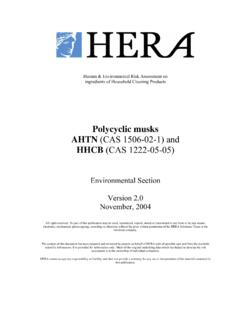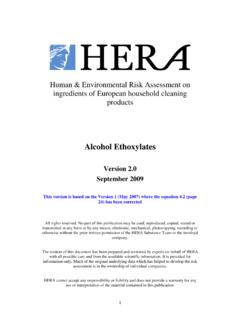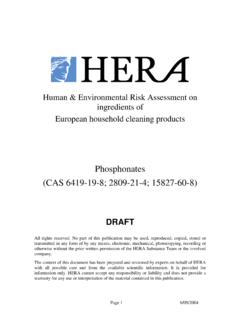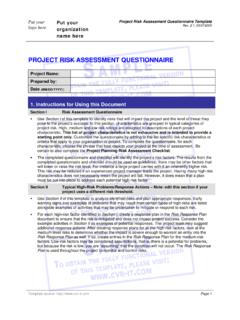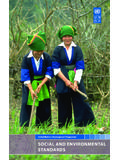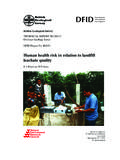Transcription of Alcohol Ethoxysulphates (AES) Environmental Risk …
1 human & Environmental Risk assessment on ingredients of European household cleaning products Alcohol Ethoxysulphates (AES) Environmental Risk assessment All rights reserved. No part of this publication may be used, reproduced, copied, stored or transmitted in any form of by any means, electronic, mechanical, photocopying, recording or otherwise without the prior written permission of the HERA Substance Team or the involved company. The content of this document has been prepared and reviewed by experts on behalf of HERA with all possible care and from the available scientific information. It is provided for information only. HERA cannot accept any responsibility or liability and does not provide a warranty for any use or interpretation of the material contained in this publication. - 1 - 1 Contents 1 2 Executive 3 Substance CAS No and Grouping Chemical structure and Manufacturing Route and Production/Volume Homologue distribution in HERA 4 Data Search 5 Derivation of Tonnage Physico-Chemical PEC 6 Aquatic Acute Chronic Mesocosm PNEC aquatic Justification for PNEC based on chronic Trends in Other Compartments Microbial Soil and Sediment Toxicity PNEC sediment and 7 Risk Aquatic Microbial - 2 - Sediment Soil 8 9 CONTRIBUTORS TO THIS RISK 10 11 Tables Table 1 Estimated tonnage and Chain length distribution of Table 2 Estimated tonnage and EO distribution of Table 3 Tonnages used in PEC Table 4 Fate of AES with in STP (fractional distribution).
2 12 Table 5 Primary degradation of AES in higher tier Table 6 Fate of AES with based on Table 7 Simpletreat PEC estimates (Scenario I)..14 Table 8 Simulation test PEC estimates (Scenario II)..15 Table 9 AES with EO= uptake by Humans as calculated with EUSES*..16 Table 10 Comparison of modelled PEC and field monitored Table 11 Chronic toxicity Table 12 Mesocosm Table 13 QSAR estimates of Table 14 Brachionus calyciflorus toxicity Table 15 PNEC aquatic (mg/l)..24 Table 16 PNEC soil (mg/kg)..26 Table 17 Aquatic risk Table 18 Soil risk Annex Annex 1 CAS # covered in Annex 2 Physchem - 3 - Annex 3 RCR based on Total - 4 - 2 Executive Summary Alcohol Ethoxysulphates (AES) are a widely used class of anionic surfactants. They are used in household cleaning products, personal care products, institutional cleaners and industrial cleaning processes, and as industrial process aids in emulsion polymerisation and as additives during plastics and paint production.
3 Uses in household cleaning products, the scope of HERA, include laundry detergents, hand dishwashing liquids, and various hard surface cleaners. The total volume of AES surfactants used in Europe is estimated to be 276,000 tonnes/year on an active matter basis of which 108,000 tonnes/year is used in household detergents and cleaning products (CESIO, 2000). A large Environmental data set is available for AES. On the Environmental fate side, this includes standard biodegradation studies, advanced simulation studies of removal in treatment systems, and field monitoring data. On the Environmental effects side, acute as well as chronic single-species data are available, as well as advanced studies in micro- and mesocosm systems. To determine the Predicted Environmental Concentration (PEC), chemical removal in wastewater treatment plants was determined from advanced simulation test data.
4 Monitoring studies on sewage treatment plant effluents indicate that the exposure estimates in this assessment are likely to be conservative. The Predicted No-Effect Concentration (PNEC) was based on chronic ecotoxicity data. Mesocosm studies suggest that the effects assessment based on laboratory studies is also conservative. By means of these higher tier exposure and effects data, it could be shown that the use of AES in HERA applications (household detergents and cleaning products) results in risk characterization ratios less than one, indicating no concern, for all Environmental compartments. An additional exposure scenario was included in this risk assessment , by assuming the entire AES tonnage used in Europe is disposed of down the drain. Using the same exposure and effects assessment approach, the absence of Environmental concerns can also be demonstrated for this total tonnage.
5 - 5 - 3 Substance Characterisation Alcohol Ethoxysulphates (AES) are a widely used class of anionic surfactants. They are used in household cleaning products, personal care products including toothpaste and shampoos, hand and other personal cleaning products, institutional cleaners and industrial cleaning processes, and as industrial process aids in emulsion polymerisation and as additives during plastics and paint production. Uses in household cleaning products, relevant to the HERA program of risk assessments, include laundry detergents, hand dishwashing liquids, and various hard surface cleaners. CAS No and Grouping information There are several CAS Numbers describing AES. A comprehensive list is presented in Annex 1 of this document. Although clearly important from a Regulatory perspective, this assessment is not based on CAS Nos., but on the Environmental fate and effects of the components of the products.
6 Chemical structure and composition The Alcohol ethoxysulphate family is defined for HERA purposes to encompass commercial grades of linear-type primary Alcohol Ethoxysulphates containing AES components of basic structure CnH2n (C2H4O)mSO4X,) where n=12-18 and m = 0-8 and X = sodium, ammonium or triethanolamine (TEA). Sodium salts of AES are by far the most commonly used grades. Further detail on the structures included in the AES family are given in Section Manufacturing Route and Production/Volume Statistics Alcohol Ethoxysulphates are produced by sulphation of the ethoxylates of primary alcohols using sulphur trioxide or chlorosulphonic acid followed by immediate neutralisation with base to produce typically a sodium salt, less commonly an ammonium salt. Minor volumes are neutralised with alkanolamines, usually triethanolamine (TEA). Most commercial Alcohol Ethoxysulphates are produced as low or high aqueous active solutions 25-30% or 68-70%.
7 Many grades of AES are produced commercially differing in the parent detergent Alcohol , the ethoxylate (number of moles of EO), the concentration of AES active matter in water, whether shipped as a solution, a paste or in solid form. Commercial sodium AES typically contain, approximately 2-4% of unsulphated Alcohol ethoxylate, 1-2% unreacted Alcohol and 15-45% Alcohol sulphate, and optionally trace amounts of inorganic pH buffering agents, depending on the active matter content and the degree of ethoxylation. The molecules included in the HERA AES family are ultimately derived from linear-type primary alcohols in the C12 to C18 range. As marketed, such alcohols usually contain a distribution of alkyl chain lengths. The linear-type alcohols include those which are mixtures of entirely linear alkyl chains, and those which are mixtures of linear and mono-branched alkyl chains, though still with a linear backbone.
8 Such alcohols and their blends are substantially interchangeable as feedstocks for AES used in the major applications falling within the scope of HERA. - 6 - The entirely-linear Alcohol feedstocks include those derived from vegetable or animal sources via oleochemical processes and those derived from ethylene via Ziegler chemistry. Such alcohols contain even numbered alkyl chains only, and are produced in single carbon cuts or more usually wider cuts from C6 through C22+. C12 through C18 grades are feedstocks for HERA AES. The essentially-linear Alcohol feedstocks, also known as linear oxo- alcohols , are derived from linear higher olefins via oxo-chemistry. The feedstock linear olefins are typically derived from ethylene or normal paraffins. Such alcohols contain mixtures of even/odd or odd numbered alkyl chains depending on the feedstock olefin, and are produced in grades ranging from C7 through C15.
9 Typically 90-40% of the carbon chains are linear, the remainder being mono-branched 2-alkyl isomers, predominantly 2-methyl. The mono-branched isomers thus have a linear backbone. C12 through C15 grades are feedstocks for HERA AES. The principle structures present in HERA C12 AES for example are: CH3(CH2)11O(EO)nSO3Na CH3(CH2)8-mCHCH2O(EO)nSO3Na | (CH2)mCH3where n varies from 0-8 and m varies from 0-4, but is primarily 0. The average value of n is for AES sold into household use and for the total AES produced. Of the AES used in consumer cleaning applications in Europe, approximately 71% is derived from even carbon numbered linear alcohols (C12-14 and C16-18), with the remaining 29% derived from odd and even carbon numbered essentially-linear oxo alcohols . Excluded from the HERA AES family are Alcohol Ethoxysulphates derived from alcohols shorter than C12.
10 The tonnages of these products are very small (<1000 tonnes/year) and their toxicity is less than that of longer chainlengths. Also excluded from the family are AES with other alkyl chain structures such as multi-branched alcohols , for example commercial iso-tridecanols. These grades of AES are not typically used in household cleaning products. Their uses are small and specialised and they are not considered further in this assessment . The European (EU, CH and NO) production volume of AES surfactants on an active matter basis is estimated to be 320,000 tonnes/y (CESIO statistics for 2000; CESIO = European Committee for Surfactants and their Organic Intermediates, a sector group of the European Chemical Industry Council, CEFIC). About 276,000 tonnes/y are estimated to remain in Europe, the remainder (44000 tonnes/yr) is exported. The imported volume is thought to be negligible.

